The Cathedral Church of Christ the King
Duke Street, Grafton
Norman & Beard 1903, rebuilt in 1967 by Hill, Norman & Beard
for the Auditorium of the Royal College of Organists in London
refurbished and re-erected in Grafton Cathedral in 1992 by Peter D.G. Jewkes Pty Ltd of Sydney
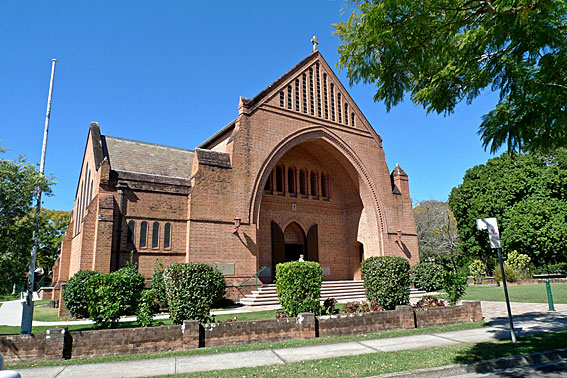
Photo: Trevor Bunning (Aug 2010)
From the Grafton Cathedral website http://www.graftoncathedral.org.au/:
History of the Organs
The first organ was installed in Christ Church Cathedral in 1884 at a cost of 450 pounds. It was a small instrument of 2 manuals and pedals built by George Fincham of Melbourne, a noted organ builder of the time and founder of a firm still building organs in Victoria.
Packed in five crates the organ was sent to Grafton by ship. The installation was carried out by the organist, Mr Mitchell, and in the Cathedral archives are charmingly pedantic letters from Mr Fincham instructing him exactly how he was to accomplish this task, even down to the fine details of removing the crates from ship to Cathedral.
The organ was erected on the North side of the chancel in the third arch of the present chapel and dedicated for worship on September 2nd, 1884 by the Bishop of Grafton and Armidale, the Right Reverend James Turner.
Operated by mechanical action, the organ had 15 stops in all while provision was made for a special indicator so that the operator of the hand bellows could keep a constant supply of wind.
When the Cathedral was enlarged in 1934 the instrument was moved to the opposite side of the choir in the large arch and chamber now occupied by the clergy vestry.
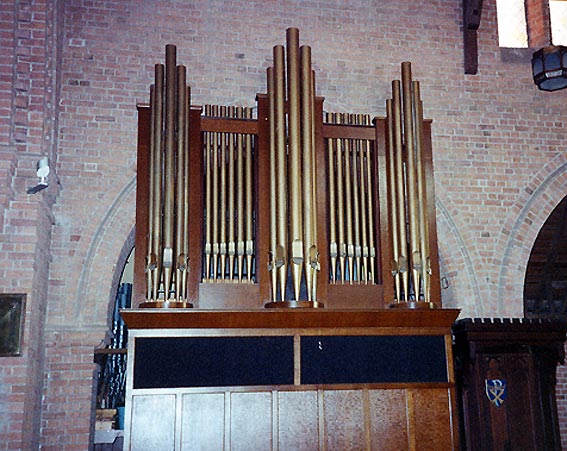
The late 1950's found the organ in very poor condition, parts even tied up with string, and clearly inadequate for the size of the completed Cathedral. Under the guidance of Mr Ray Matchett, the Cathedral Organist, some additions and electrification of the action were carried out by Hr H J Jarrott of Brisbane and dedicated on September 3rd, 1962.
Due to lack of funds these additions fell short of Mr Matchett’s vision and the instrument was still too small for the size of the building. As a memorial to Mr Matchett and the Diocesan Registrar, Mr Arthur Singleton, further additions were made through the efforts of the Technical College Choral Group.
A thorough assessment of the organ, as part of the 1984 Cathedral Restoration, made it clear that band-aid solutions could no longer suffice; its condition, its inadequate size and site were such that the considerable expense required to rectify these problems could not be justified.
The Restoration Committee appointed an Organ Sub-committee to examine the question of a replacement organ and its placement in the archway on the North side of the choir. John Horbury Hunt, the Architect who designed the Cathedral, had marked this as the chamber for the organ on his original plans.
The search for a suitable instrument continued and in 1990 the Royal College of Organists accepted Grafton Cathedral’s tender for the purchase of its organ situated in the auditorium of the Exhibition Building next door to the Royal Albert Hall in London. The instrument had become redundant as the College was relocating to new premises which already had a fine organ.
Peter Jewkes and Co., organ builders of Sydney undertook the contract to have the instrument dismantled, packed, shipped to Australia, refurbished and re-erected in the Cathedral.
The principal of the firm, Mr Peter Jewkes, was very helpful to the Committee in its search for a suitable instrument and his expertise and dedication proved invaluable.
The task of dismantling and packing was undertaken by Paul Pickerill of Birmingham. Like its predecessor this organ also came by sea, arriving in two large steel containers in December 1990.
Built originally in 1903 by English firm, Norman and Beard, the instrument had been enlarged in 1931 and then completely rebuilt with many additions in 1967 by Hill, Norman and Beard. It was used by the college for recitals and for the examination of candidates for College diplomas.
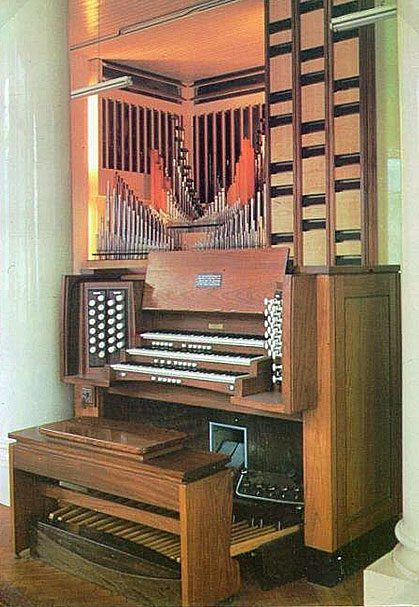
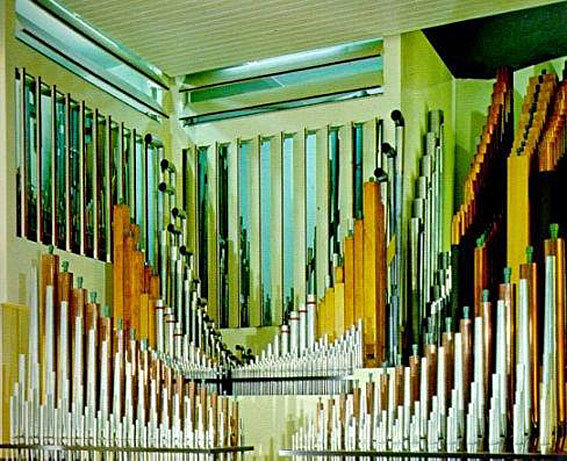
The organ in the Royal College of Organists, Kensington Gore, London
The organ has 3 manuals and pedals and 37 speaking stops with a full range of couplers allowing the divisions to be joined together for extra versatility. A feature is that all speaking stops are individual ranks - there are no “extensions” or “borrowing”.
The whole organ is laid out in a visible arrangement. Pipes are of “spotted” and plain metal, copper, tin and brass; the wooden pipes are high grade spruce. The console is polished African Afrormosia. The action is electric and electropneumatic while the controls incorporate the most modern solid state equipment. The swell division is enclosed in a chamber with shutters which can be opened and closed allowing expressive effects.
This instrument not only fulfils its prime function of accompanying the liturgy for both Parish and Diocesan occasions but it it also excellent for accompanying choral work. For recitals its versatility satisfies the requirements of most schools of organ literature and already it has attracted the interest of many well known and respected organists in Australia and from overseas.
Peter DG Jewkes Pty Ltd restored the soundboards and pipework, releathered the actions, rewired and solid-stated the electrics, and undertook some minor revoicing for the organ's new acoustics in 1992.
In February 2005, Peter DG Jewkes Pty Ltd added a large trumpet type solo reed stop (“Tromba Graftoniensis”) to the choir division which was donated by Dr Richard Vesey, sometime Chapter Clerk. This addition will broaden the range of available solo stops as well as adding weight to the total ensemble.
Ian D Brown & Associates have added some electronic stops since taking over its tuning a few years ago, using Peterson components.
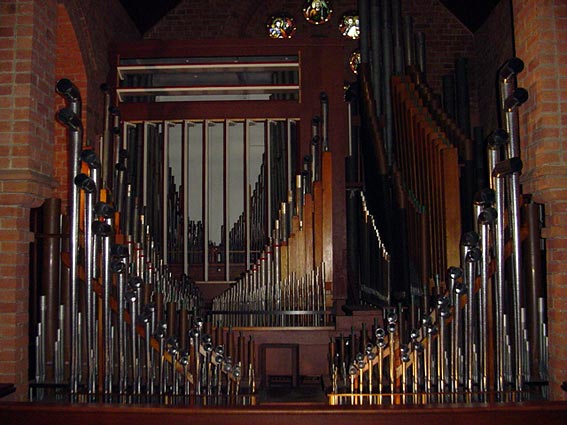
Present organ showing new Solo reed (Robert Eather)
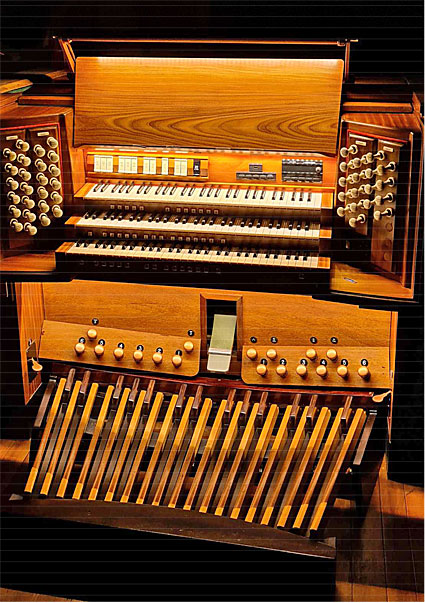
Rebuilt console (2021) [Photo: Ian Brown]
Rebuilding the console (SOJ Autumn 2021) by Ian Brown: The Cathedral Church of Christ the King, Grafton, to give it its full title, has been our workplace recently. The story of this organ begins in London where Norman & Beard Ltd of Norwich built a three- manual organ for the Royal College of Organists in 1903. In the middle of the twentieth century the world seemed to rediscover baroque and earlier music. Many beautiful new organs were built in varying degrees of being faithful copies of historic instruments in Europe and with varying degrees of success. However, there are also many examples of what occurred where funds were not available to build a new instrument, so baroque-like alterations and additions were made at the cost of ruining an existing organ. It has to be said that the rebuild of the RCO organ by Hill, Norman & Beard in 1967 changed forever the character of the Norman & Beard organ. It will also forever be the subject of some interesting debate. Some will like it. Some will say it is the wrong organ for the cathedral. Our approach has been to keep our opinion out of the public forum but to focus on whatever improvements we can make to it within the constraints of a budget and a feeling that “ït is what it is”. The console of this organ became famous by being upheld as the RCO standard for console dimensions adding some sentimental value to its history. The Royal College of Organists moved away from Kensington Gore in West London to another location and the organ became redundant. It was ultimately bought by Christ Church Cathedral. Here I must pay tribute to Peter Jewkes and his team, especially Rodney Ford for the 1992 installation in Grafton. There were some complex alterations which had to be made for the organ to fit the space. There were numerous repairs which would have been needed for it to work. Some new electrical components were in- stalled. Leather work has obviously been undertaken, some at the time of installation, some later. A very fine Tromba was added. We took over the maintenance of the organ a few years ago but not because of any dissatisfaction of the cathedral authorities for the work of Peter Jewkes. It was a simple agreement between all parties that the cost of maintenance was an issue and since we passed by there about ten times each year perhaps we should care for it. Our approach to this instrument has been that we should ensure that whatever work we undertake should put the organ into better condition and improved tone. We have always found the cathedral authorities and musicians open to supporting us in these endeavours. After a couple of tuning visits it became obvious that many of the organ’s recurring problems were in the console. The combination capture system suffered occasional glitches and sometimes failed to work entirely. Contacts in the draw stops were in very poor condition and stops would frequently not work. Keyboards were exceptionally worn. Ivories were becoming thin in places. Keys had side play. Ivories were falling off. Contacts were unreliable. Spring tensions were irregular. Pedal contacts on some notes were so badly bent it was difficult to keep them working. Our feeling was that this console was already worn out when it arrived in Grafton from students practising for their FRCOs. Possibly no finance was available for such extra work over and above the installation cost. We also had to put this work on hold and hope for a time when it could be undertaken. Meanwhile it was possible to undertake a few other improvements and repairs. A pedal concussion bellows was re-leathered. Pipes of the Choir Singendgedackt 8’ were always going out of tune because of their cork stoppers shrinking in dry weather. These were sent to Tim Gilley, organ pipe maker, for the fitting of metal canister stoppers. Although the original Norman & Beard organ would have had a heavyweight Pedal Open Wood 16ft, this disappeared in 1967. The 16ft Metal Principal which replaced it and the Contra Gamba 16ft, previously a Swell stop, just do not provide the organ with the firm foundation one expects to hear on a three manual organ of this size. Unfortunately, there was available neither funds nor space to add large 16ft pipes. Three stops have been added in electronics. Major Bass 16’, Contra Bass 32’ and Contra Posaune 32’. The organ is transformed by having a firm bass. Late last year it became possible to make plans to rebuild the console and a quote was prepared. As I write this in the last week of November 2020 we are putting the finishing touches to this project. The console was disconnected and transported to our factory. A few weeks were spent on repairs to the woodwork. New pieces were made to replace the very worn track for the roll top. So badly worn in fact, that the roll top was scraping over the top of the draw stop jambs. The roll top itself was starting to fall apart so new fabric was glued to the back. At Grafton the Choir Organ is unenclosed. A redundant Choir pedal was removed allowing space for extra toe pistons. A new curved knee panel and toe piston sweeps were made. Restoration of the old keyboards was considered. In the end the decision to provide new keyboards was the better option. The old keyboards were in poor condition and would have needed recovering with a material which would not be ivory, re-bushing, new pins, new springs and new contacts. They then would not have the superb touch of modern keyboards with top resistance to provide a “tracker like” feel. The new keyboards have been specially fitted with square replica Hill, Norman & Beard style thumb pistons to preserve the general appearance of the old keyboards. New pedal contacts were fitted and the pedal board re-felted. New draw stops were provided. These have a full one-inch movement with a toggle action. New warm white console lighting was used to replace the very hot halogen light used previously - a huge benefit in the Grafton summer for organists wearing robes. The light bar fitting above the music desk I made on the lathe. It has a groove for the LED light strip. This can also be tipped over to lie flat on top of the console when not in use. Of great benefit is the new organ operating system. This operates all of the functions in the console: combination capture system, stops, keys, notes, couplers and much more. Music can be recorded and played back later. There is a transposer. A visiting organist could save all combinations to a flash drive. Returning years later these could be reloaded to the console. The console is connected to the organ chamber with only an eight-wire data cable. An organ builder section protected by a password provides many options including a comprehensive diagnostic section and the ability to download alterations or additions to the organ’s configuration. Connections for MIDI are provided. There is a piston sequencer enabling a piece of music with complex registration changes to be played through using repeated pressing of the same “Next” piston. Three of these are provided, two for thumbs and one for toes. These are just a few of the main features but the system has much more to offer and the Grafton organists are beginning to learn their way around it. Imagine a situation where the organist leaves the console to go and conduct the choir for the anthem and the organ plays a previously installed accompaniment.
|
The specification is:
| Great Organ Bourdon Open Diapason Stopped Diapason Octave Chimney Flute Wald Flute Mixture Trumpet Swell Organ (enclosed) Flûte à cheminée Viole de Gambe Viole Celeste Principal Flute Ouverte Nazard Quarte de Nazard Tierce Mixture Basson Hautbois Trompette Tremulant Choir Organ (unenclosed) Salicional Singendgedackt Spitz Flute Principal Larigot Sesquialtera Scharf Krummhorn Tromba Graftoniensis Tremulant Pedal Organ Contra Bass Major Bass Principal Sub Bass Contra Gamba Octave Gedackt Choralbass Mixture Contra Posaune Posaune Rohrschalmei Couplers Swell to Great Choir to Great Swell to Choir Swell to Pedal Great to Pedal Choir to Pedal |
16 8 8 4 4 2 IV 8 8 8 8 4 4 2-2/3 2 1-3/5 III/IV 16 8 8 8 8 4 2 1-1/3 II IV 8 8 32 16 16 16 16 8 8 4 III 32 16 4 |
added 2016, digital voice by Peterson Electro-Musical Products Inc.* added 2016, digital voice by Peterson Electro-Musical Products Inc.* A acoustic in bottom octave, 2016 * A |
Accessories
Thumb Pistons
5 Adjustable pistons to Great
5 adjustable pistons to Swell
5 adjustable pistons to Choir
10 adjustable pistons to all stops
1 Swell to Choir
1 Choir to Great
1 Great to Pedal
1 Swell to Pedal
1 Choir to Pedal
1 General Cancel
Toe Pistons
5 to Pedal
5 to Swell
1 Swell to Great
1 Great to Pedal
1 Pedal Posaune
2 kick pedals - Great to Pedal (left)
Swell to Great (right)
Piston Couplers
Great and Pedal pistons coupled
General pistons on Swell toe pistons
Pistons adjustable by capture system
Accessories to the Organ
Electric metronome
Tremulant speed control
Compass: Manuals CC-c, 61 notes
Pedals CCC-g, 32 notes
* Ian D. Brown & Associates, Newsletter (December 2016), p. 2.
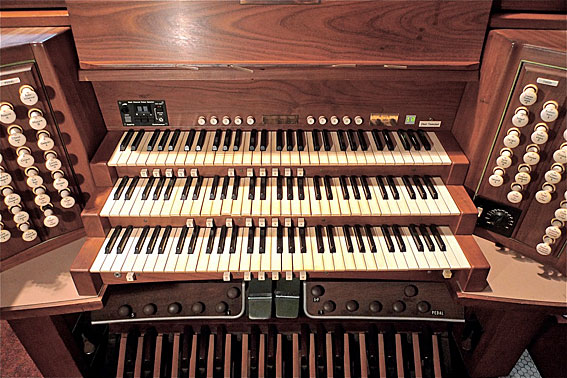
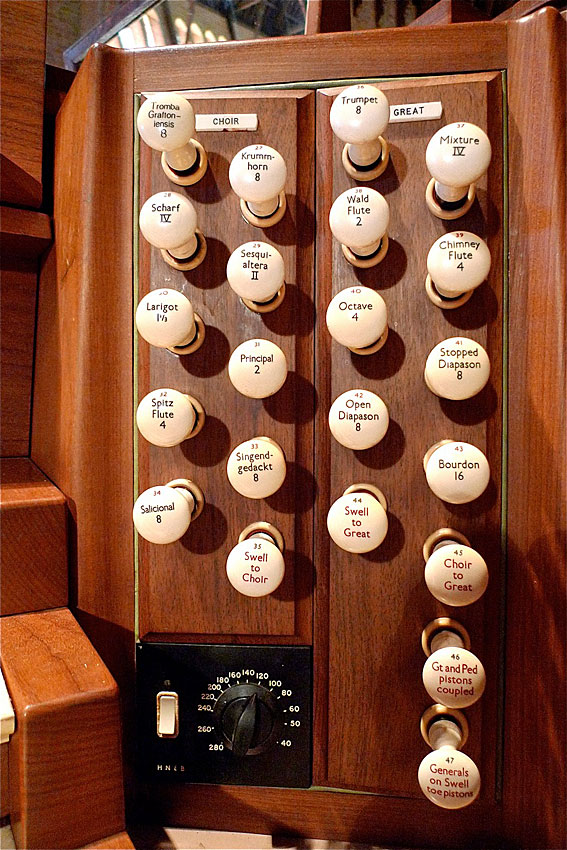
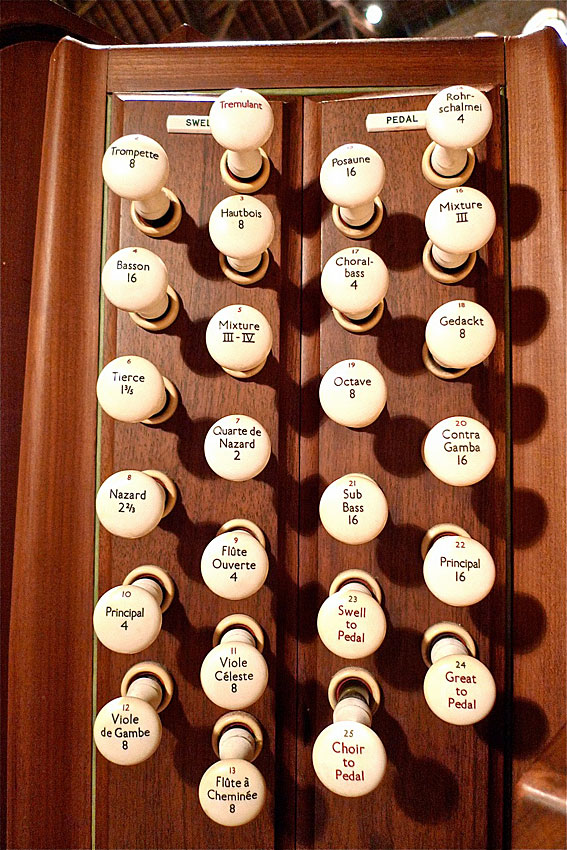
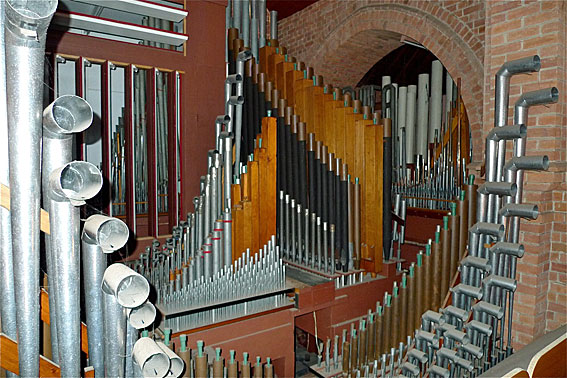
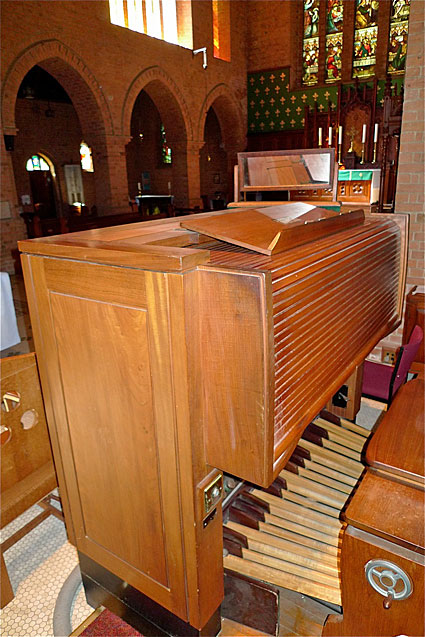
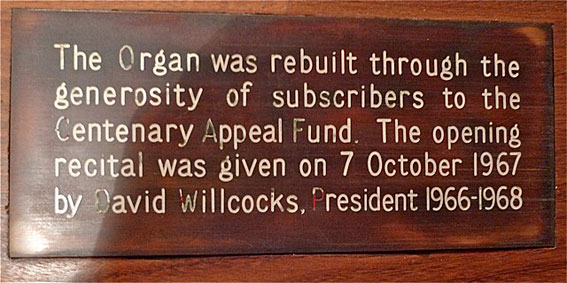
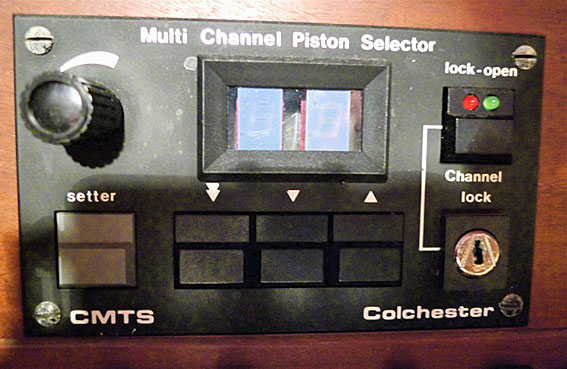
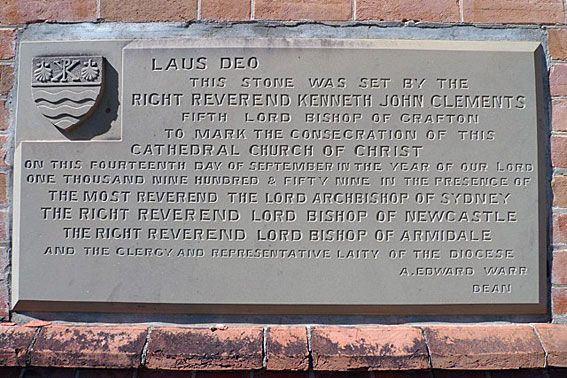
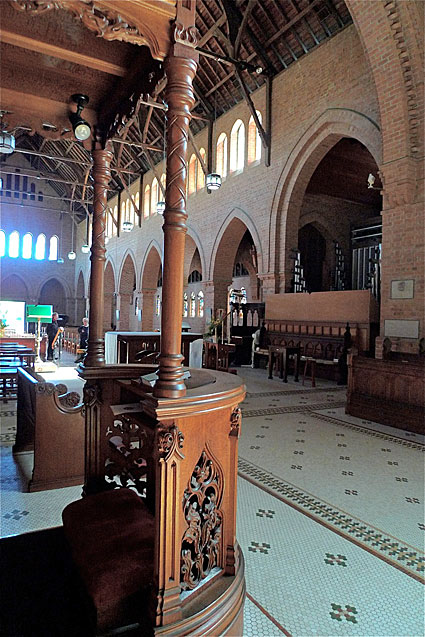
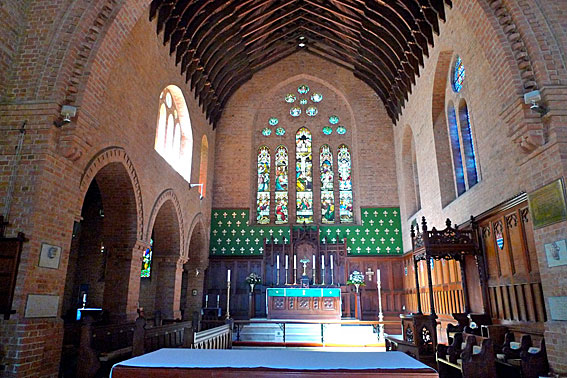
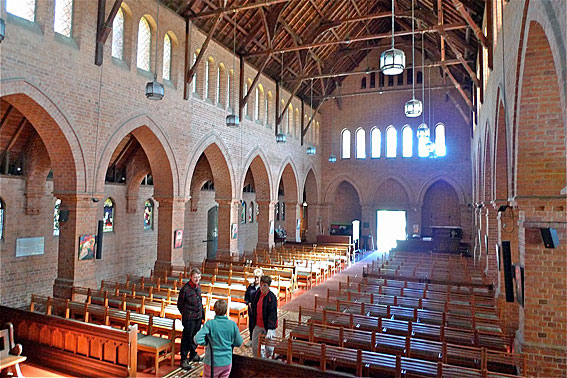
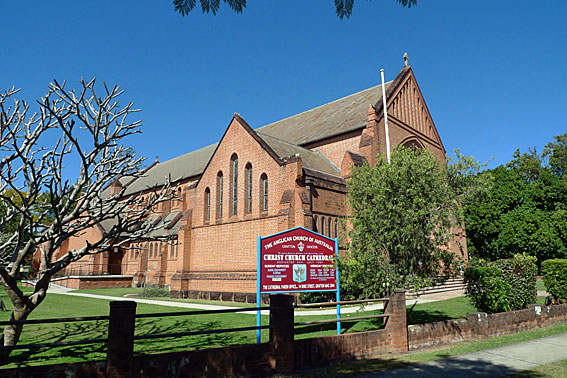
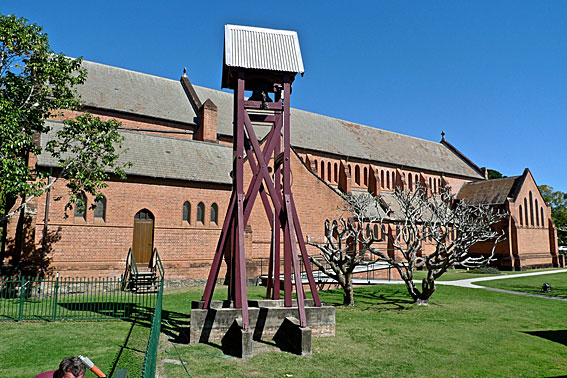
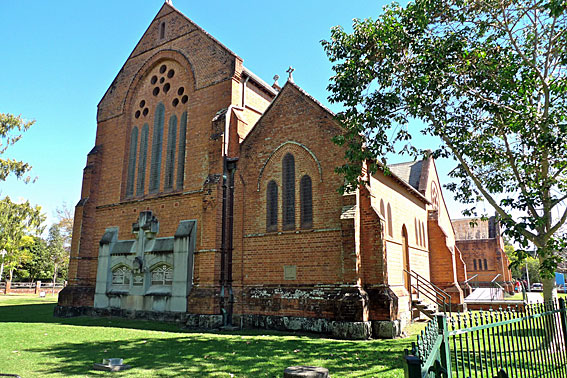
Photos above: Trevor Bunning (Aug 2010)
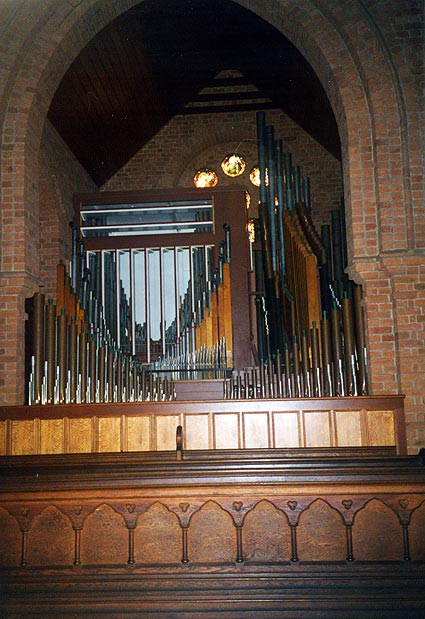
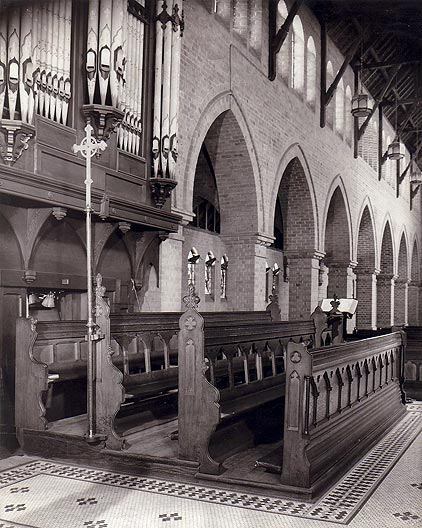
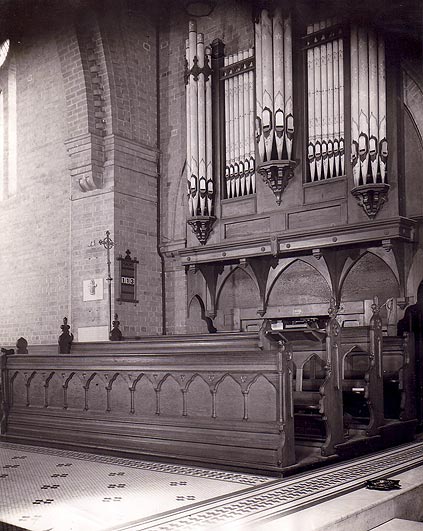
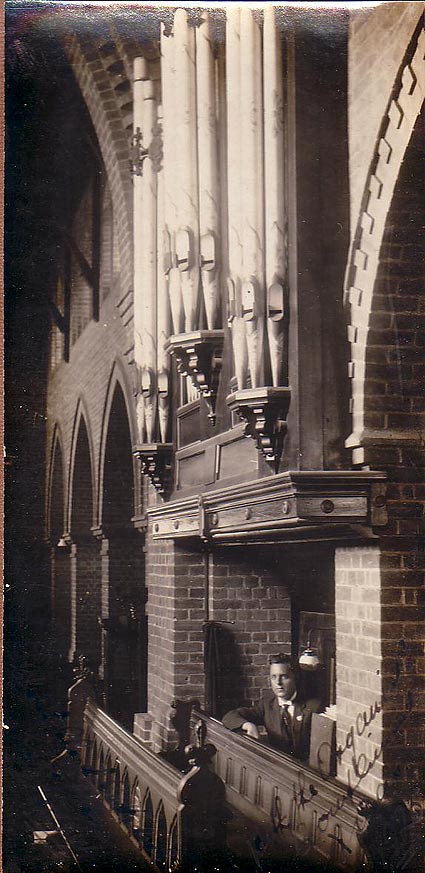
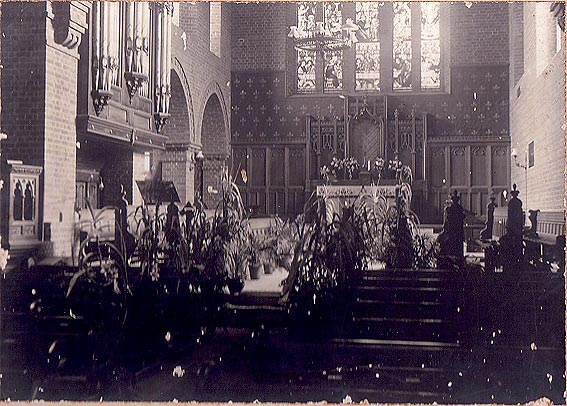
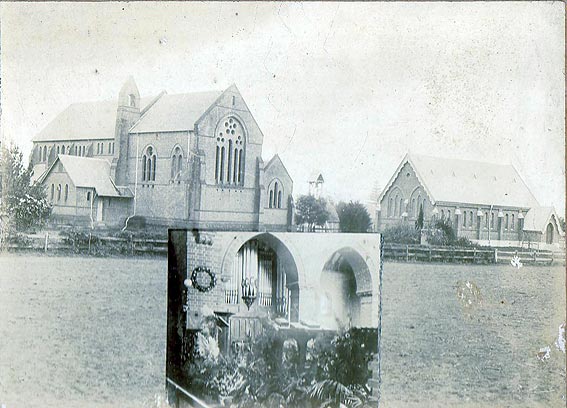
Historic photos: Robert Eather (Cathedral Organist) 2006